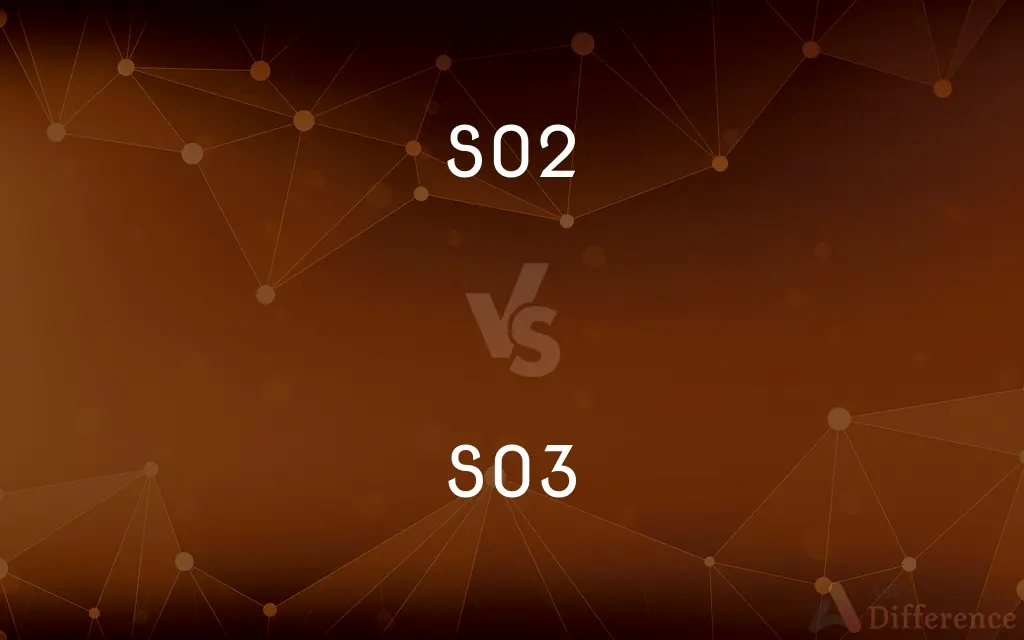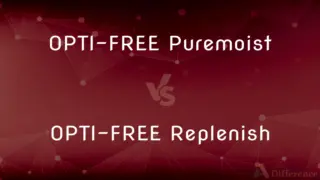SO2 vs. SO3 — What's the Difference?
By Tayyaba Rehman — Published on December 11, 2023
SO2, or sulfur dioxide, is a colorless gas with a pungent odor, primarily used as a disinfectant or preservative. SO3, or sulfur trioxide, is a dense, toxic smoke used to produce sulfuric acid. Both are oxides of sulfur but differ in oxygen content.

Difference Between SO2 and SO3
Table of Contents
ADVERTISEMENT
Key Differences
SO2 and SO3 are both chemical compounds consisting of sulfur and oxygen, known as oxides of sulfur. SO2, which stands for sulfur dioxide, contains one sulfur atom bonded to two oxygen atoms. This molecule is recognized by its sharp, irritating odor and is often associated with the smell of burnt matches. On the other hand, SO3, or sulfur trioxide, is made up of a single sulfur atom bonded to three oxygen atoms. It's less commonly encountered in everyday life but plays a pivotal role in industrial applications.
In terms of chemical properties, SO2 is a colorless gas at room temperature and is soluble in water, forming sulfurous acid. This acid solution has disinfectant properties and has historically been used as a food preservative. SO3, contrastingly, reacts violently with water, generating heat and forming sulfuric acid. This strong acid is a cornerstone chemical in many industries, from battery manufacturing to fertilizer production.
From an environmental perspective, SO2 is a significant air pollutant. Emissions mainly arise from the burning of sulfur-containing fossil fuels, like coal and oil. When SO2 enters the atmosphere, it can lead to acid rain, which harms aquatic life, forests, and even man-made structures. Conversely, SO3 is not directly released in significant amounts into the atmosphere. However, in the presence of atmospheric water vapor, SO2 can be further oxidized to form SO3, which then contributes to the formation of acid rain.
To summarize, while both SO2 and SO3 are sulfur oxides, they possess distinct chemical properties and play different roles both in nature and in human-made processes. SO2 is more commonly recognized for its environmental impact, while SO3 is essential in the production of one of the most produced chemicals globally: sulfuric acid.
Comparison Chart
Number of Oxygen Atoms
2
3
ADVERTISEMENT
Physical State at Room Temp.
Colorless gas
Dense, white smoke
Reaction with Water
Forms sulfurous acid
Forms sulfuric acid, releasing heat
Primary Use
Disinfectant, preservative, pollutant
Producing sulfuric acid
Environmental Impact
Major contributor to acid rain
Formed from SO2, also contributes to acid rain formation
Compare with Definitions
SO2
Used historically as a disinfectant and preservative.
Wine makers sometimes add SO2 to prevent spoilage.
SO3
Not a primary atmospheric pollutant but forms from SO2 oxidation.
SO3 itself isn't usually emitted, but it can form in the atmosphere.
SO2
A molecule containing one sulfur and two oxygen atoms.
SO2 has a pungent smell often linked to burnt matches.
SO3
Central in the production of sulfuric acid in industry.
Factories producing sulfuric acid have SO3 as an intermediate compound.
SO2
A precursor to acid rain formation.
Elevated SO2 levels in the atmosphere can lead to environmental concerns.
SO3
A compound of sulfur and oxygen, typically a dense smoke.
The chemical reaction produced a white cloud of SO3.
SO2
A gaseous compound of sulfur and oxygen.
Emissions of SO2 have decreased due to cleaner fuel regulations.
SO3
A molecule with one sulfur and three oxygen atoms.
SO3 is an oxide of sulfur with a higher oxygen content than SO2.
SO2
A recognized air pollutant from burning sulfur-rich fuels.
The coal plant's emissions were high in SO2.
SO3
Reacts exothermically with water to form sulfuric acid.
Handling SO3 requires caution due to its violent reaction with moisture.
Common Curiosities
How many oxygen atoms are in sulfur trioxide?
Sulfur trioxide, SO3, contains three oxygen atoms.
What is the chemical representation for sulfur dioxide?
The chemical representation for sulfur dioxide is SO2.
Is SO2 harmful to the environment?
Yes, SO2 is a major contributor to acid rain and air pollution.
What's the primary industrial use of SO3?
SO3 is primarily used to produce sulfuric acid.
How does SO2 impact human health?
Inhalation of SO2 can irritate the respiratory system and exacerbate asthma.
Is it safe to handle SO3 directly?
No, SO3 reacts violently with water and can cause burns.
Can SO2 be found naturally in the atmosphere?
Yes, SO2 can be released from volcanic eruptions and other natural processes.
Which compound, SO2 or SO3, has a pungent smell?
SO2 is known for its sharp, irritating odor.
Why is SO3 crucial for battery manufacturing?
Because it's used to produce sulfuric acid, a key component in lead-acid batteries.
Can both SO2 and SO3 be found in industrial emissions?
Yes, though SO2 is more commonly emitted, SO3 can also be present or form rapidly from SO2.
Why is SO3 not a common direct air pollutant?
SO3 is not typically released directly but forms from SO2 oxidation in the atmosphere.
Can SO3 be formed from SO2 in the atmosphere?
Yes, SO2 can oxidize to form SO3, which then contributes to acid rain.
Is SO2 used in food processing?
Yes, SO2 has historically been used as a disinfectant and preservative.
How does SO2 affect aquatic ecosystems?
SO2 can lead to acid rain, which can harm aquatic life by acidifying water bodies.
What physical state is SO3 in at room temperature?
At room temperature, SO3 is typically a dense, white smoke.
Share Your Discovery

Previous Comparison
AISI vs. ASTM
Next Comparison
OPTI-FREE Puremoist vs. OPTI-FREE ReplenishAuthor Spotlight
Written by
Tayyaba RehmanTayyaba Rehman is a distinguished writer, currently serving as a primary contributor to askdifference.com. As a researcher in semantics and etymology, Tayyaba's passion for the complexity of languages and their distinctions has found a perfect home on the platform. Tayyaba delves into the intricacies of language, distinguishing between commonly confused words and phrases, thereby providing clarity for readers worldwide.
















































